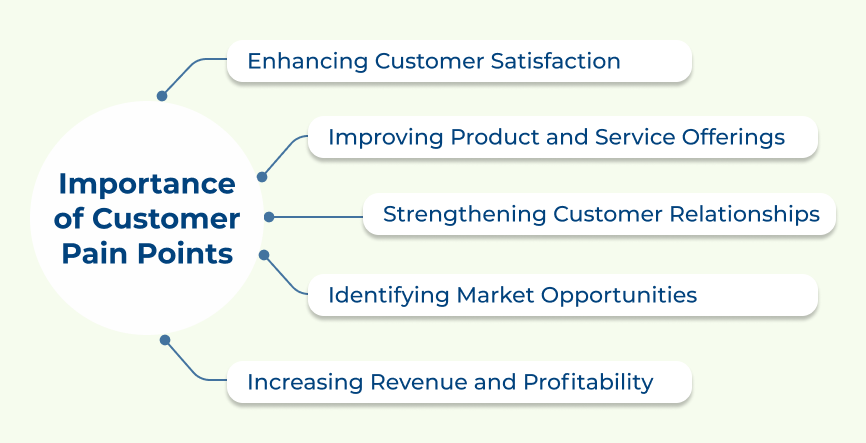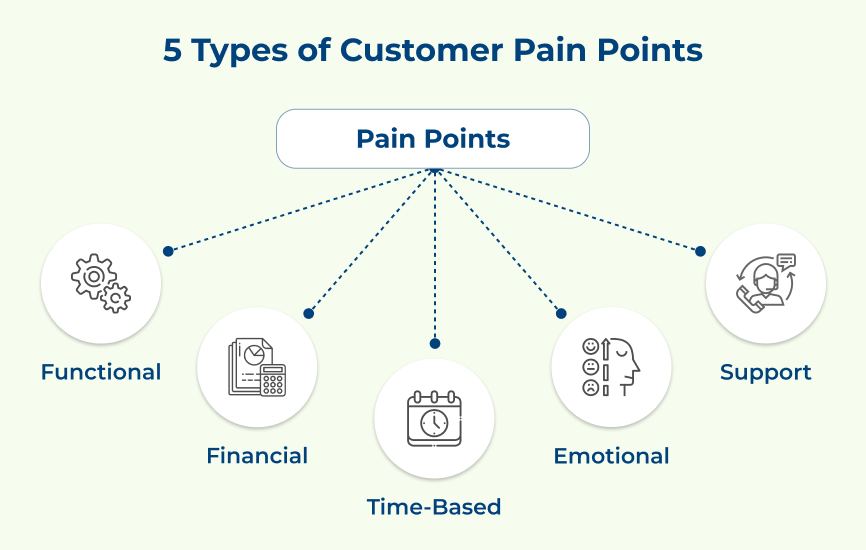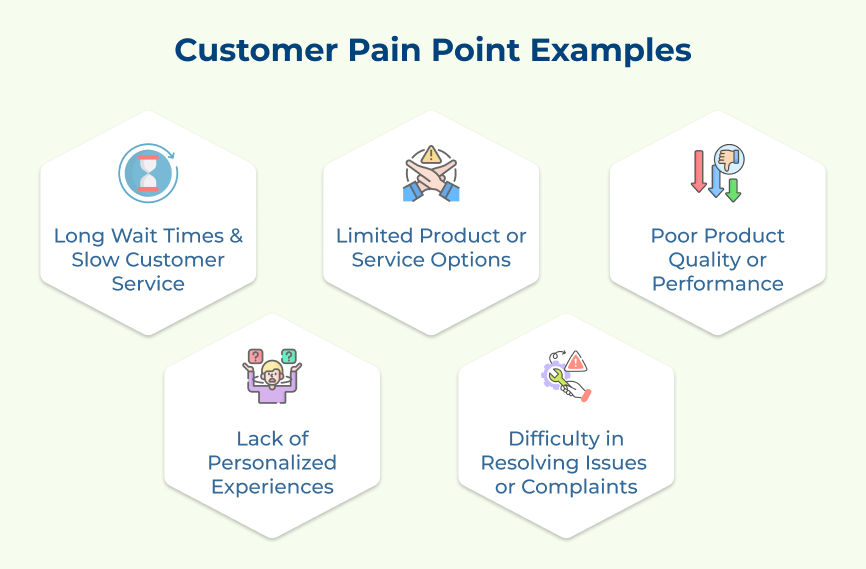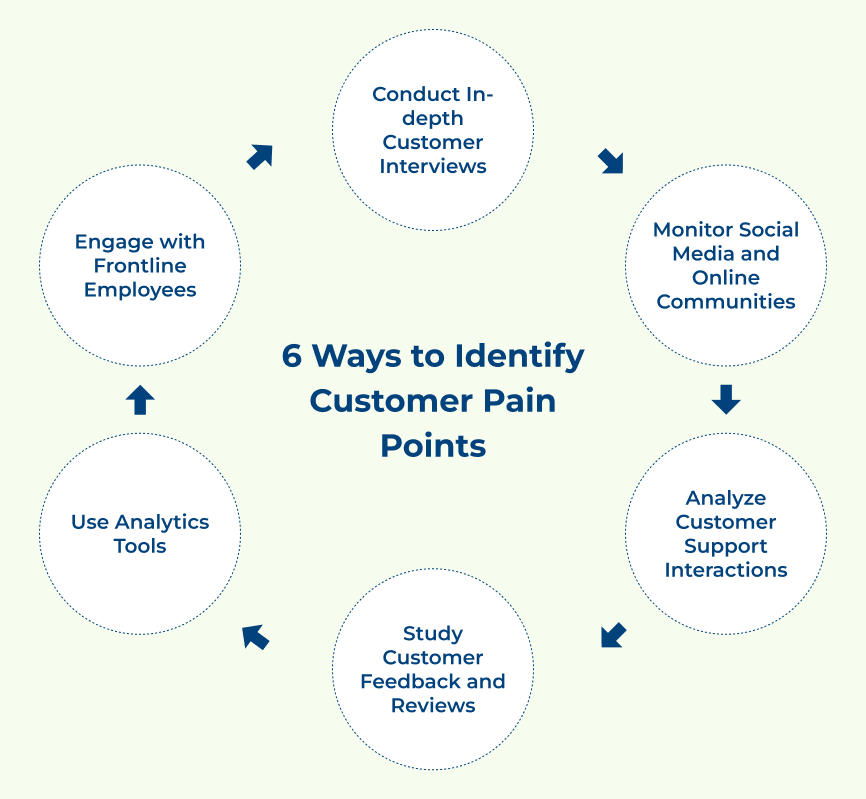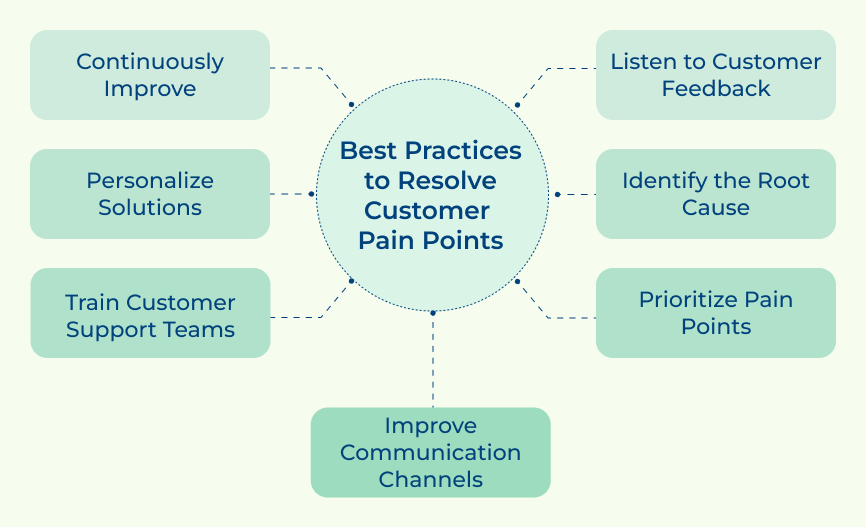1. Conduct In-depth Customer Interviews
Conducting in-depth customer interviews is one of the most effective ways to identify customer pain points. Businesses can develop targeted solutions that address their pain points and provide them with a superior experience. It can be easily done by gaining a deep understanding of the customer’s needs, challenges, and frustrations.
Understanding the area of concern is crucial for all businesses. It enables them to tailor their offerings to meet the specific needs of the user. One can easily differentiate their brand from competitors and create a unique value proposition by resolving the concerns.
How to implement:
Prepare for the interviews: Define the objectives and research the target customers’ preferences. Develop a list of open-ended questions to know the pain points candidly.
Identify the interviewees: Select a diverse group of customers who represent the prospective customers. Consider factors such as age, gender, location, and usage patterns to ensure a comprehensive understanding of pain points.
Ask probing questions: Use the prepared questions as a framework, but be flexible and delve deeper into their responses. Encourage them to provide specific examples and elaborate on their experiences.
2. Monitor Social Media and Online Communities
One crucial aspect of customer engagement is monitoring social media and online communities to identify customer service pain points. Businesses can tailor their products, services, and marketing strategies to provide effective solutions by understanding the issues faced by customers.
The rise of platforms like Facebook, Twitter and Instagram means that customers have readily available platforms to express their opinions. Businesses can gain valuable insights into what their customers are saying about their brand, products, or services by actively monitoring these channels.
How to implement:
Use social listening tools: Social listening tools are essential for keeping track of conversations and mentions of the brand across various social media platforms. Businesses can identify common pain points and areas of improvement by analyzing the data.
Engage in active customer interaction: Actively engaging with customers through social media and online communities is another powerful way to identify their pain points. Businesses can gain insights into specific pain points customers are facing.
Monitor competitor activities and customer sentiment: Keeping an eye on the competitors and understanding the sentiments of customers can provide valuable insights. Tracking overall customer sentiment will reflect the general mood and preferences of the prospective customers.
3. Analyze Customer Support Interactions
Customer support interactions are a crucial aspect of any business, as they provide valuable insights into the pain points of the customers. Analyzing the interactions allows the company to understand the needs and frustrations of the customers. It is quite vital for improving the service and providing a better overall customer experience.
Identifying customer pain points gives businesses a competitive edge, as it allows them to address specific issues that may be hindering customer satisfaction. Analyzing customer support interactions enables companies to fetch valuable feedback and data that can help them make informed decisions to resolve these pain points.
How to implement:
Collect and categorize customer feedback: Start by collecting customer feedback from various channels, such as phone calls, emails, and social media. Categorize the feedback based on the specific pain points or issues mentioned.
Monitor customer sentiments: Pay attention to the emotions expressed by customers during their interactions with the support team. Take note of any negative or frustrated sentiments, as they often indicate pain points.
Use technology for analysis: Utilize customer support software or analytics tools to extract meaningful data from customer interactions. The tools can help identify trends, track customer satisfaction metrics, and provide actionable insights to address pain points effectively.
4. Study Customer Feedback and Reviews
Understanding the customers and their pain points is crucial for any business looking to provide excellent customer service. One effective way to gain this insight is by studying customer feedback and reviews.
Analyzing the reviews and feedback allows enterprises to address specific issues. It also helps in the identification of trends and patterns that can drive the decision-making process. Feedback and reviews remain to be one of the most effective ways of getting insights into the pain points of the users. This is why 49% of customers claim to trust online reviews as much as personal recommendations.
How to implement:
Monitor online platforms: Keep a close eye on customer feedback and reviews on various online platforms. Look for recurring themes or common complaints that will help to pinpoint specific pain points.
Conduct surveys and interviews: Take a proactive approach by directly reaching out to the customers for feedback through surveys. The personalized approach can provide invaluable information to improve the customer experience.
Analyze customer data: Utilize the current customer data to identify pain points. Look for patterns in customer behavior, such as high customer churn or low engagement rates.
5. Use Analytics Tools
Analyzing and understanding customer pain points is crucial for any business looking to improve its products or services. Pain points are essentially problems or challenges that customers face. Identifying them allows businesses to address and resolve these issues effectively.
Adopting analytics tools enables businesses to collect and analyze vast amounts of data, providing valuable insights into customer preferences. Businesses can make informed decisions and develop strategies to improve their solutions by understanding what frustrates customers.
How to implement:
Conduct customer pain point analysis: Businesses can identify trends and patterns that reveal common pain points by customer pain point analysis. The information can then be used to address these issues and enhance the customer experience.
Utilize social media monitoring: Social media platforms are a goldmine of customer insights and opinions. Monitoring social media conversations and sentiment analysis allows businesses to identify pain points that customers may be experiencing and respond accordingly.
Implement user testing and surveys: Analytics tools can be used to conduct user testing and collect feedback through surveys. Businesses can gather valuable insights to drive improvements by directly engaging with customers.
6. Engage with Frontline Employees
Engaging with frontline employees is crucial when it comes to identifying customer service pain points. They are the ones who have direct contact with customers on a day-to-day basis, making them a valuable source of information. 70% of employees feel the empowerment to take action when their customer experiences a problem is important for them.
Businesses can facilitate a sense of ownership and empowerment among their staff by actively involving the employees in resolving customer support pain points. The result will be enhanced customer satisfaction and loyalty.
How to implement:
Regular feedback sessions: Schedule regular feedback sessions and create a safe environment where the employees feel comfortable sharing their insights about user pain points.
Empowerment and training: Provide the necessary training to frontline employees to enhance their ability to identify and address customer pain points. Empower them to make decisions and take actions that will benefit the customer, within reasonable bounds.
Recognition and rewards: Recognize and reward frontline employees who actively participate in addressing customer pain points. It encourages them to continue their efforts and motivates others to do the same.
Best Practices to Resolve Customer Pain Points
Explore the best practices for identifying, analyzing and resolving customer pain points to promote loyalty.






